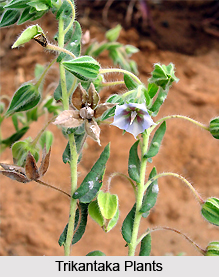 Trikantaka is an Indian medicinal plant found in the drier habitats and wastelands throughout peninsular India from Gujarat and Madhya Pradesh to the southern parts of West Bengal. The botanical name of this plant is Trichodesma zeylanicum. This medicinal plant is commonly known as Barakalpa in Bengali, Jalasirasa in Hindi, Jalashirasi in Marathi, and Trikantaka in Sanskrit.
Trikantaka is an Indian medicinal plant found in the drier habitats and wastelands throughout peninsular India from Gujarat and Madhya Pradesh to the southern parts of West Bengal. The botanical name of this plant is Trichodesma zeylanicum. This medicinal plant is commonly known as Barakalpa in Bengali, Jalasirasa in Hindi, Jalashirasi in Marathi, and Trikantaka in Sanskrit.
This medicinal plant is a stout, annual herb which grows up to a limit of 30 cm to 60cm. The stems are erect and often purple in colour. The leaves are opposite, varies from 5 cm to 10 cm in length and 1.3-2.5 cm wide. The upper leaves are sessile or very short-petioled whereas the lower leaves present with petioles that measure 4 mm to 13 mm in length. Flowers of Trikantaka plant are pale blue in colour, numerous, solitary and axillary or in irregular form. Calyx lobes of these flowers are divided to the base and are appressed-hairy. These are rounded at base, have 8 mm long segments, lanceolate, acute, with a strong midrib. The corolla tube are 5 mm in length, obovate, triangular, apex rounded with a sudden spirally 2.5 mm long twisted tip. The fruits of Trikantaka plants are ellipsoid, nutlets ovoid-oblong, smooth, obscurely margined, and of 4 mm to 5 mm long. These become grey-brown colour when ripe.
Trikantaka plants are important or its medicinal values. Several medicines are prepared from the plant parts. In Ayurveda the plant is used for the treatment of leucoderma and piles. The leaves of this medicinal plant possess emollient, demulcent and diuretic properties and are used to prepare emollient poultices. The powdered root is applied to wounds to cure pain.
This article is a stub. You can enrich by adding more information to it. Send your Write Up to content@indianetzone.com











